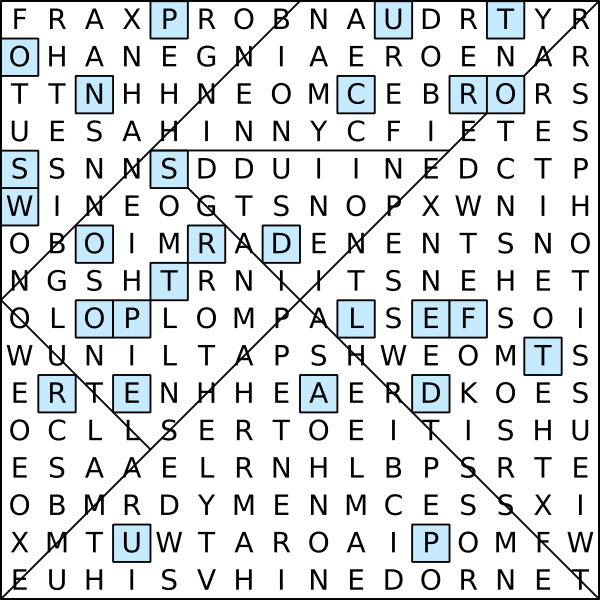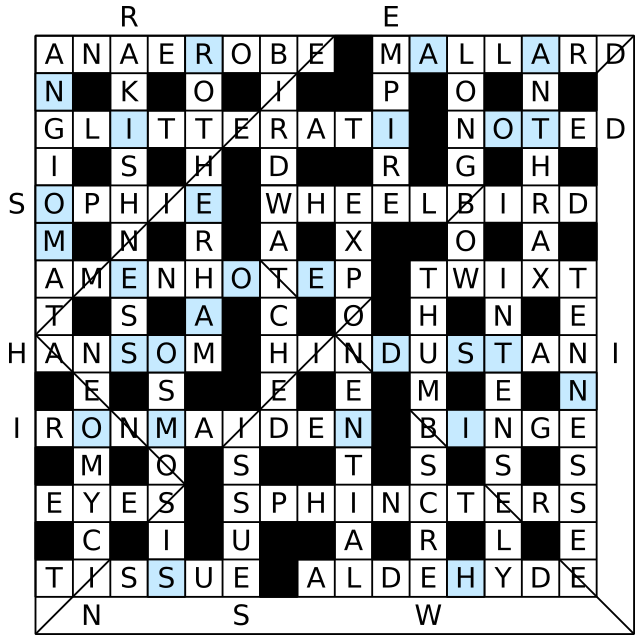| Home Register Puzzles Solve Teams Statistics Rules Solving Guide F.A.Q. Archive mezzacotta |
Solution: 4E. Tangram Mix-up
The puzzle consists of a set of tangram shapes with some unusual blue squares and triangles overlaid, plus a series of fifteen angular black silhouette shapes. In traditional tangram puzzles, the solver is provided with a silhouette shape template, and the puzzle is to arrange the seven tangram pieces to reproduce the shape.
The black shapes here are rather more complicated than the simple forms one could construct with traditional tangrams, but these tangrams have extra details in the blue squares, which one might suppose should be cut out to form holes in the shapes. At first glance, it might seem feasible that the shapes could be reproduced with these modified tangrams. However, any such attempt soon runs into insurmountable obstacles, as the silhouettes are simply too complicated and of unusual relative dimensions.
The twist to this puzzle which needs to be realised is that all of the Thursday puzzles in this competition are interrelated, and rely on information from other puzzles. The black shapes turn out to be required to solve puzzle 4D. Signs of Change, and are not required here at all. Rather, the correct first step involves realising that the small blue squares are 1/16 the size of the large square made up by the tangram shapes as presented. This matches the letter grid provided in puzzle 4A. All Astir, which is a 16×16 grid of letters. In fact, if the puzzle PDF files are printed out on the same size paper, the size of the tangram square and the letter grid match perfectly.
At this point one could conjecture that the tangrams are intended to be rearranged into a square, such that the blue triangles abut one another to form squares, and then the whole arrangement overlaid onto the letter grid. If the blue squares are cut out, some of the letters could be read through the holes, hopefully to spell out some message.
There are hundreds of possible arrangements of the tangram shapes into a square, but the constraint provided by the triangular blue half-squares needing to combine to make squares reduces this down to 16 possible internal constructions, multipied by 4 rotations and 2 reflections of the overall square, for 128 possible ways to place them on the letter grid. A lot, but certainly doable. In practice there are two approaches to make this search easier: look for a partial message when laying down the triangles to lock some of them into place and cut down the possibilities, or write a computer program to do the exhaustive search quickly.[1]
The correct layout looks like this (in practice the letters not in the blue boxes would be covered by the tangram shapes):

The message reads: PUT ON CROSSWORD TOP LEFT READ UP
This refers to the crossword grid found in puzzle 4C. Crossover Word. That grid is 15×15 letters rather than 16×16, but it has been designed so that if printed on the same paper size, the individual letter squares are exactly the same size as the letter squares in the 16×16 grid. So if we align the tangram square to the top left corner of the crossword grid, it will overlap by one square along the right and bottom edges.
Of course, doing this with the empty crossword grid won't reveal any letters. We have to fill the crossword grid first! The correct way to do that involves essentially solving puzzle 4A. All Astir, as that puzzle involves entering words into the crossword grid (see the solution to All Astir). Once the words are entered, we can overlay the tangram square, without rotating or reflecting it, and then read a new message upwards, as instructed by the first message:

Reading upwards in columns, starting from the left, reveals: MONO SEISMO AERO EN DIA HISTO TAN
These are all partial words which can be made into full words by appending -GRAM:
The last word ties back to the theme of the puzzle. The solution is the missing word suffix, a word in its own right: GRAM.
During the competition, a team wrote to suggest that we should also accept the answer GRAMS, especially given that there were seven -GRAM words presented. In hindsight, we should have accepted that as well, as clearly the puzzle is solved by that point. But, as always, the accepted answers cannot be changed mid-competition, as it would disadvantage some teams.
Puzzle design notes
The idea for this puzzle initially came about from the idea for a metapuzzle for the ultimately cancelled 2014 CiSRA Puzzle Competition. That metapuzzle idea required one of the group puzzles to use the theme of tangrams (see this year's Metapuzzle solution for details). Rather than the traditional use of tangrams to match provided silhouette shapes, I wanted to do something new. Then later I had the idea for the linked group of puzzles, and the plan to use tangrams do something unique crystallised into shape as part of the interactions between puzzles. The concept of laying shapes with holes over a letter grid is not particularly original, but the added twist of having to first determine that that's what you need to do amidst all the possibile inter-puzzle interactions made it more interesting.
The first message composed was by trying to find a suitable message in the words of the completed crossword grid. This was more constrained than the word search grid, as the crossword had fewer letters, and also had to satisfy several other constraints imposed by the puzzles All Astir and Crossover Word. Once the crossword was fixed, I tried to use its letters to spell out a coherent message. This proved to be so difficult that I had to search for a different strategy, and after some failed attempts finally hit on the idea of simply listing a set of words with the suffix -GRAM removed. The suffix was chosen to allow the final word to be TAN-GRAM, thus neatly tying the puzzle in a self-referential loop. Even so, I had to resort to the trick of reading the grid upwards to find enough suitable words.
Having generated this end-step message, I now had the job of writing another message with exactly the same number of letters, indicating how to extract the end-step message. The word CROSSWORD had to be in it, as well as the instruction to READ UP. With just a few letters left, I managed to make the message both coherent and provide the tip that the tangram square had to be aligned to the top left corner of the crossword grid (since they are different sizes).
The message PUT ON CROSSWORD TOP LEFT READ UP, combined with the constraint provided by the positions of the holes in the tangrams (in turn constrained by the positions of the letters needed to make the end-step message), provided a fixed set of letters in the All Astir grid, that could not be changed to suit any other puzzle. So those then had to be incorporated as a constraint in the design of both 4A. All Astir and 4D. Signs of Change.
[1] During testing of this puzzle, different testers successfully used both approaches.
